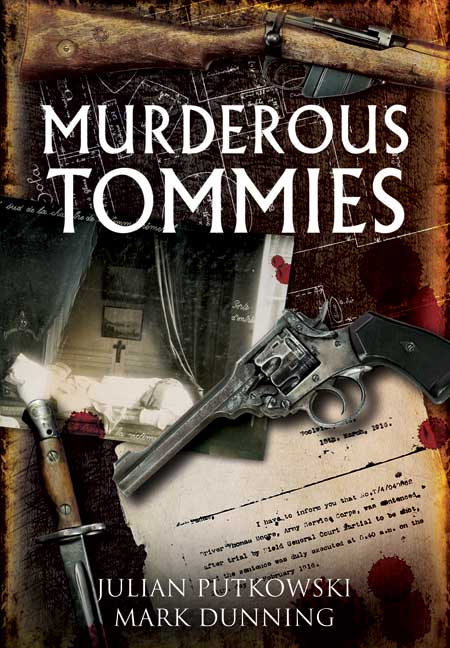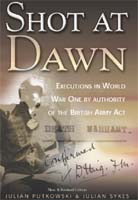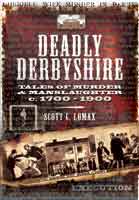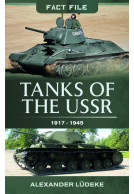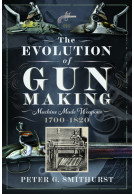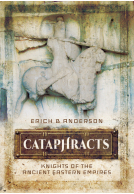Murderous Tommies (Hardback)
Imprint: Pen & Sword Military
Pages: 224
ISBN: 9781848846265
Published: 13th September 2012
(click here for international delivery rates)
Need a currency converter? Check XE.com for live rates
| Other formats available - Buy the Hardback and get the eBook for free! | Price |
|---|---|
| Murderous Tommies eBook (13.2 MB) Add to Basket | £6.99 |
Much has been written about the soldiers executed during WW1 for military offences, all of whom were conditionally pardoned in 2006. However, until now very little attention has been paid to the cases of men who were tried under the Army Act and executed for murder.
The British Army has always been reticent about publicising courts martial and eighty years elapsed before the government was compelled to prematurely declassify the written proceedings of First World War capital courts martial. Even then, public attention tended to concentrate on cases involving soldiers who had been shot at dawn for offences other than homicide, and virtually nobody was inclined to seek a posthumous pardon or judicial review for the murderous Tommies. This meant neither the victims' nor the convicted men's families were able to discover details about the murder cases.
Though readily identifiable online via much-visited war cemetery websites, until now there has been no readily accessible, historically reliable and balanced narrative about the activities and courts-martial of all the murderous Tommies of the Western Front. This book provides for a full account of the cases involving twelve soldiers and one officer whose homicidal misdeeds were committed in France and Flanders while hostilities were in progress.
Drawing on contemporary records, this carefully researched work chronicles the circumstances in which each of these men either slaughtered one of their comrades or an unarmed civilian. It examines the murderer's motives and presents a balanced analysis of each case, including a detailed assessment of the extent to which each condemned man was granted a fair hearing by officers who sat in uneasy judgement as well as those involved in confirming the death sentences.
This book is a cure for romanticism and well worth reading... The main interest of the book is the picture of the life of soldiers in France and Belgium. Putkowski and Dunning's depiction of the soldiers are not the stead fast heroes we imagine on Remembrance Day; nor are they the virtuous victims we find in Morpurgo-style weepie-fiction. They are very human.
Great War Fiction
The mutineers, however, had their whit knight in the form of university lecturer and historian Julien Putkowski who, ably supported by Mark Dunning, has now focused on a few Murderous Tommies. As with the men executed for alleged battlefield offences , the families of these other men - and their victims - deserve to know what happened to their loved ones. Putkowski and Dunning set out to do just that in a well-researched, "warts and all" study of the cases.
fishingforanglers.com
Apart from being an excellent read the authors’ introduction provides the best summary to date of the entire capital court martial episode.
The western front association stand to! No. 97
The story of 12 soldiers and 1 officer whose homicidal misdeeds were committed in France and Flanders during World War 1.
Pennant Online
War of course, is a violent affair. Even though it may result in the death of thousands, and it may appear that the individual lives count for little, it is still the case that one death is a tragedy. So it was that in the midst of the terrible slaughter of the First World War, a murder was still treated as a capital crime and the perpetrators, if found guilty, faced the death sentence just as they would in peacetime. Murderous Tommies details the court cases that followed tweleve of these murders. All tweleve cases examined are fascinating in their own way.
Britain at War
For around forty years there existed a vehement anti-militarist culture against the military establishment for the "stupidity", "butchery" of the General Staff in the First War. More precisely, since Judge Anthony Babington's For the Sake of Example For the Sake of Example: Capital Courts Martial, 1914-20, and in particular Sykes & Putkowski's Shot at Dawn Shot at Dawn: Executions in World War One by Authority of the British Army Act, made more public in the largely fictitious BBC series The Monocled Mutineer by Alan Bleasedale The Monocled Mutineer : The Complete BBC Series (2 Disc Set) [DVD] [1986]the anger was directed to the injustice taken against the "thousands" of Tommies shot for desertion, and cowardice (now thought to be suffering with symptoms of "shell shock" or PTSD), who were placed side by side with common murders.
Amazon Reviewer
On being elected PM, Tony Blair wished to go down in history as the "straight sort of guy" and appearing popular with everyone. Instead, when passing his Armed Forces Act, in 2006, he succeeded, first, in alienating the military with what the media described as a "blanket " pardon, and secondly, annoying the interested families by refusing to revoke or quash the convictions of the Great War, simply by representing the majority of those shot as "victims of war", and stressing their sentences were "not a fate that they deserved". To their delight, however, the victims were henceforth distinguished from "executed murderers".
Putkowski & Dunning's present book focuses on 13 Britons who were tried and executed in France or Flanders for murder while hostilities were in progress. Each case is set out one after the other in chronological order beginning with the first of L/Cpl Price and Pte Morgan (2 Welsh) killing of CSM Hayes in January 1915 around Bethune, a case first noted in the Robert Graves' personal diary, subsequently included in his published Goodbye to All That, with a brief comment of the inconclusive or ambiguous aspects, until July 1918, with the death in Calais of SM Collison, DCM (MP) at the hands of Lt Paterson (1 Essex). It concludes with a two page summary conclusion, and three appendices: a relevant two page appendix on the procedures of Courts Martial; a useful break down of Courts Martial sentences handed to both officers and other ranks (ORs) throughout the conflict between September 1914 up to November 1918 for capital offences excluding murder: comprising mutiny, cowardice, desertion, sleeping at one's post, and striking a superior; and one on the sites of mourning of the victims and killers. The statistics thus dismiss the belief that "thousands" were sentenced: in effect a total of 52 officers, and 17,178 ORs were shot over the four years. The chapters on each case vary in length of between 7-47 pages, some with illustrations of the protagonists, and murder weapons, as well as sketch maps.
It is unclear precisely what is the long term aim of the authors other than perhaps to begin re-opening the past cases for their families. Clearly, as in all similar examinations I feel it was primarily in the short term a genuine curiosity to assert that typical legal stereotypes are very untypical, and might be only stereotypes if one decides to read the cases thoroughly through particular blinkers. In certain cases, such as Pte Dale (13 Royal Scots), in early 1916, whose military record was unblemished by any misconduct, the War Office allowed campaign medals be kept and warn by the killer's family; in other not.
From these 13 cases the authors admit that the material available is incomplete as documents either were misplaced, lost, destroyed during the Second World War, or perhaps have purposely disappeared. As the persons who adjudicated in the Courts Martial have since died, or if are still living are well over 120, it will be impossible at this date to attempt to fill the missing gaps.
However, from the final brief summary the authors conclude that there were many injustices made. In four instances: Cpl Chisholm (RE) at Bailleul, near Ypres, in May 1915, Pte Knight (10 Royal Welsh Fus) at Eecke, in November 1915, as well as in the above mentioned cases of Morgan and Price, and Paterson, they were required to defend themselves in limited time and without legal assistance of the Prisoner's Friend. In case after case, officers focused on the immediate situation in which the homicidal act occurred, and ensured the hearings simply confirmed the defendant's guilt. In assessing motive little account was taken especially in eight cases that the defendant was drunk, distressed or mentally deranged at the time when the offence was committed nor was medical advice was requested.
Though authors underline the socially restricted profile of officers staffing influencing the decision, they never considered the legalistic public formal language of the middle class may have completely confused the uneducated ORs more attuned to their own private code of the back streets and the trenches. They do state that "institutional" considerations: the object of military law, never misguided the confirmatory process, so that the inappropriate soldierly conduct was solely considered at the expense of the very act of killing another man. Most of all, even when there was doubt, or when senior officers noted inconsistencies, as in the case of Pte Dale, and Pte Reid (16 Highland Light Infantry) in January 1917, FM Sir Douglas Haig seemed to reaffirm in strongest terms the sentence of death. It represents the traditional Clark image of the wild, immovable "donkey"The Donkeys showing no compassion or clemency for his men rather than a revisionist post-war fatherly founder of the Haig Homes for ex-servicemen. The authors underline that what Haig and his ilk were doing was personally culling the proverbial black sheep from the flocks in the trenches, and so were no less worthy to be treated leniently as comrades than the men whose deaths they ordained. They also believed they were right as stated in the Bible, and were doing good for all. The question is are they accusing Haig and co for their actions, or simply justifying them? They can't be empty-headed donkeys and geniuses even in the Army.
The two most interesting cases were the longest one at Le Havre in December 1917 on L/Sgt Wickens (9 Rifle Bde), and the one involving Lt Paterson. The first, because it concerned a civilian, Henriette Tremerel, a 52 widow, an unlicensed prostitute; the second because it concerned an officer. In the case of the former, it is of interest because the French police showed total discrimination, overlooking the death of a French woman fallen in bad ways, someone useless, at the expense of an active British fighting man; whereas the British Courts Martial were not prepared to give further time to discover if there was a case of mistaken identity and the act had been carried out by another Tommy. For them their man had to go. In contrast, in the latter case, the officer was not sentenced for murder, but for desertion in the face of the enemy, something which the military had complete full understanding. As he had enlisted in the ranks and later commissioned, his action, furthermore, was not becoming of an officer and a gentleman; and as in TV version of The Monocled Mutineer the young officer came first to be demoted and then executed. Putkowski & Dunning state that as Paterson was also in debt, and had considered suicide, he would have saved the Army time and further trouble by simply shooting himself. The only real problem then was for the Army having to explain the unexplainable to a young grieving wife at home.
My major reservation of the book is in the order and layout of the cases. It needs more editing for effect to underline the issues of drunk, and or war fatigue, as well as other issues; it requires illustrating if the killing was premeditated or a complete mistake, and thus should have been commuted to manslaughter with a different sentence. I feel the authors are leaving the readers to perform as judge and jury, and in this they need more assistance before considering taking to the bar.
The book will primarily interest students or members of the military undergoing training in the law, by trying to re-examine real past cases with both old and modern techniques. For the general reader interested in detective stories such a task is not pie in the sky. One should only think back to Colin Dexter's The Wench is Dead when Inspector Morse attempted to re-examine the case of a 140 year old murder on the Oxford canal from his hospital bed The Wench Is Dead (Inspector Morse).
If Julian Putkowski & Mark Dunning intend to amass support to re-examine the evidence in future, it will be a long time in coming, as few politicians will want to press for something which has not been thought through in full. No one will burden themselves with half measures otherwise the spirit of Blair will haunt them, and someone further in the future will be obliged to continue the saga.
About Mark Dunning
Mark Dunning combines his successful career as a lawyer specialising in legal redress with a twenty year long research interest in British Army capital courts martial cases. In 2010 he was awarded an MA in Modern British History by the University of York.
About Julian Putkowski
Julian Putkowski is a university lecturer residing in Hackney and a member of the Scientific Committee of the In Flanders Fields Museum, Ieper. Since 1978 his research about the British Army during the Great War has featured in many radio and TV programmes, including The Monocled Mutineer (BBC); Going Home (Opix), and Mutiny (Sweet Patootee). Julian writes authoritatively about mutinies and military misdeeds, and with Julian Sykes he co-authored Shot at Dawn and supported the campaign to secure posthumous pardons for the executed men.







